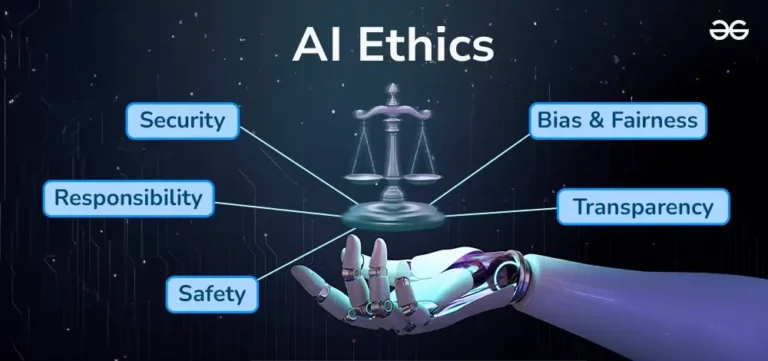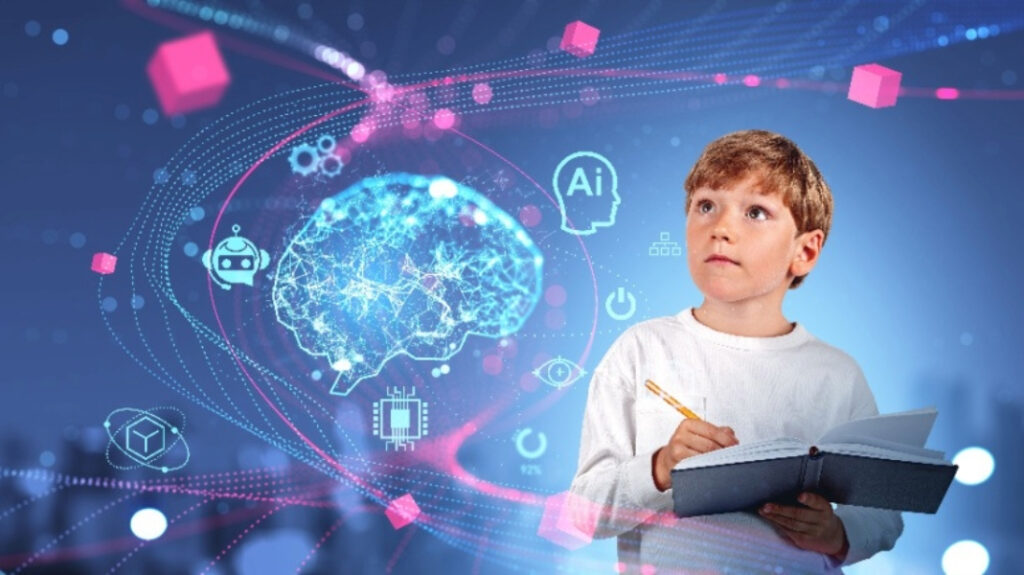Types, Applications, History, Challenges, and Generative AI
Types of AI:
- Narrow AI (Weak AI): Narrow AI is designed to perform a specific task efficiently. Examples include virtual assistants like Siri or Alexa, recommendation systems on platforms like Netflix, and facial recognition software. These systems operate under pre-defined parameters and cannot perform tasks outside their scope.
- General AI (Strong AI): General AI refers to systems that possess the ability to understand, learn, and perform any intellectual task that a human can do. While still theoretical, general AI aims to mimic human cognitive functions entirely.
- Superintelligent AI: This type of AI surpasses human intelligence across all fields, including creativity, problem-solving, and emotional intelligence. Superintelligent AI remains a concept discussed in speculative and ethical debates rather than practical development.
- Reactive Machines: These AI systems can analyze specific inputs and provide outputs without memory or learning capabilities. IBM’s Deep Blue, the chess-playing computer, is an example of a reactive machine.
- Limited Memory AI: Limited memory AI can use historical data to make decisions. Self-driving cars are an example, as they analyze past and current data to navigate roads safely.
- Theory of Mind AI: This type of AI is theoretical and focuses on understanding human emotions, beliefs, and social interactions to respond appropriately.
- Self-Aware AI: A futuristic concept, self-aware AI would have its consciousness, self-awareness, and emotions, leading to ethical and existential debates

Real-Life Applications of AI
- Healthcare: AI-powered systems assist in diagnosing diseases, analyzing medical imaging, and predicting patient outcomes. Chatbots provide mental health support, and robotic surgeries enhance precision.
- Finance: AI helps in fraud detection, risk assessment, and algorithmic trading. It streamlines customer support through chatbots and automates repetitive financial tasks.
- Transportation: Autonomous vehicles, route optimization, and traffic management systems leverage AI to improve efficiency and safety.
- Retail: AI enhances customer experiences with personalized recommendations, virtual fitting rooms, and inventory management systems.
- Education: AI facilitates adaptive learning platforms, automated grading, and virtual tutors, making education more accessible and personalized.
- Entertainment: AI is used in content recommendation systems, video game development, and even generating music and art.
- Agriculture: AI-powered drones, precision farming tools, and crop monitoring systems help optimize yields and reduce resource usage.
History of AI
- 1950s: Alan Turing proposed the Turing Test to assess machine intelligence. The term “Artificial Intelligence” was coined by John McCarthy in 1956 during the Dartmouth Conference.
- 1960s-70s: AI research focused on symbolic reasoning, but limitations in computational power hindered progress.
- 1980s: The rise of expert systems marked a breakthrough in AI. These systems used rule-based logic to mimic human expertise in specific domains.
- 1990s-2000s: AI gained mainstream attention with IBM’s Deep Blue defeating chess champion Garry Kasparov in 1997. Machine learning techniques began to dominate AI research.
- 2010s-Present: Advancements in deep learning, natural language processing, and computer vision have propelled AI into everyday life, powering tools like Google Translate and autonomous vehicles.


Challenges and Risks of AI
- Bias and Fairness: AI systems can inherit biases from training data, leading to discriminatory outcomes. Addressing bias is critical to ensuring fairness.
- Privacy Concerns: The extensive data collection required for AI raises concerns about privacy and data security.
- Job Displacement: Automation threatens to displace jobs in certain sectors, necessitating workforce reskilling.
- Security Threats: AI can be exploited for malicious purposes, such as creating deepfakes or automating cyberattacks.
- Ethical Issues: The development of AI, especially autonomous weapons and superintelligent AI, raises ethical questions about control and accountability.
- Lack of Transparency: AI systems often operate as “black boxes,” making it difficult to understand their decision-making processes.

Generative AI
Generative AI: Transforming Creativity and Innovation
Generative AI is one of the most exciting and rapidly advancing fields within artificial intelligence. Unlike traditional AI systems that focus on classification, prediction, and decision-making based on historical data, generative AI goes a step further by creating new data whether that be images, text, audio, or even video—based on the patterns it has learned from the existing data. This capability opens up numerous possibilities, making generative AI a powerful tool for creative fields, as well as industries looking to innovate in ways previously unthinkable.
What is Generative AI?
At its core, generative AI refers to systems that are designed to generate new content or data that mimics the characteristics of existing data. It works by learning the underlying patterns, structures, and relationships within a dataset and then using that understanding to create something original. For example, a generative AI model trained on thousands of images can generate new images that resemble the ones it learned from. Similarly, a model trained on text data can write coherent and contextually relevant articles or stories.
The most well-known approach to generative AI is through deep learning models such as Generative Adversarial Networks (GANs), Variational Autoencoders (VAEs), and Transformer-based models. These models consist of two main components: a generator and a discriminator. The generator creates new content, while the discriminator evaluates whether the generated content is similar to real data. Through this adversarial process, the model continuously improves, generating highly realistic outputs.
Applications of Generative AI
Generative AI has found applications in various industries, transforming creative processes and enhancing productivity. Some of the most notable areas where generative AI is making an impact include:
Art and Design: Generative AI is revolutionizing the art world by enabling artists to create new pieces based on certain styles or themes. AI tools like DALL·E can generate images from textual descriptions, offering limitless possibilities for visual storytelling. Designers can use generative AI to create logos, illustrations, and even product designs, pushing the boundaries of creativity.
Content Creation: In the realm of content creation, AI is being used to generate articles, blog posts, poetry, and even scripts. GPT (Generative Pre-trained Transformer) models, like OpenAI’s GPT-3, can write high-quality content on a variety of topics, making it easier for businesses to produce marketing copy, news stories, and other written materials. Additionally, AI-generated music and audio compositions are gaining popularity in both commercial and creative settings.
Healthcare and Drug Discovery: Generative AI has immense potential in healthcare, particularly in drug discovery and molecular biology. AI models can generate new molecular structures that may lead to the development of life-saving drugs. These systems can identify previously unseen combinations of molecules that could have therapeutic effects, accelerating the drug discovery process.
Gaming and Entertainment: In the gaming industry, generative AI is used to create realistic game environments, characters, and levels. By learning from previous games, AI can generate dynamic content that adapts to the player’s actions, offering a unique and personalized experience every time. Additionally, AI is being used to generate realistic dialogue in video games and films, enhancing storytelling and character development.
Fashion and Retail: Generative AI is also transforming the fashion industry by creating new clothing designs based on trends, consumer preferences, and previous collections. AI-generated designs can be used for prototype creation, allowing brands to quickly bring innovative products to market.
Challenges and Ethical Considerations
While the potential of generative AI is vast, there are several challenges and ethical considerations that need to be addressed. One major concern is the potential misuse of generative AI for creating deepfakes—realistic, but fabricated videos or audio recordings that can deceive the public. This has raised concerns about misinformation, privacy, and trust, especially in political and media contexts.
Another challenge is the risk of bias in AI-generated content. If the data used to train generative models contains biases, the output can reinforce harmful stereotypes or inequalities. For example, AI-generated content might unintentionally perpetuate gender or racial biases, which could have negative consequences in various industries.
Finally, there’s the issue of intellectual property. As AI systems generate content that closely resembles existing works, questions arise about authorship and ownership. Who owns the rights to AI-generated artwork or music? These are legal and ethical issues that need to be addressed as generative AI continues to evolve.
The Future of Generative AI
The future of generative AI holds immense promise. As the technology continues to improve, it will likely enable even more sophisticated and realistic creations. We may see AI systems that can generate high-quality video content, create immersive virtual environments, and produce personalized experiences for users. In creative industries, generative AI may become an indispensable tool for artists, musicians, writers, and designers, enhancing their ability to produce innovative work.
Additionally, as AI models become more ethical, explainable, and capable of learning from smaller datasets, their applications will broaden, transforming industries like education, entertainment, and marketing.
In conclusion, generative AI is a powerful and transformative technology that is reshaping the way we create and interact with content. As it continues to evolve, it will push the boundaries of creativity, efficiency, and innovation, offering new opportunities while also presenting new challenges to navigate.






